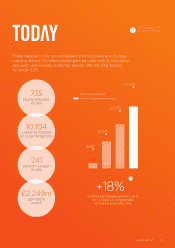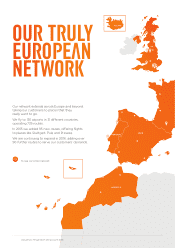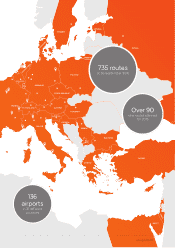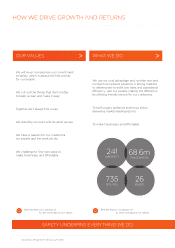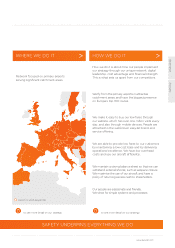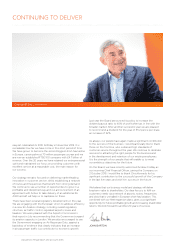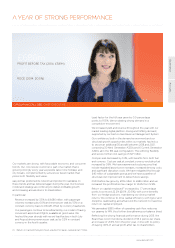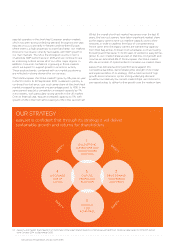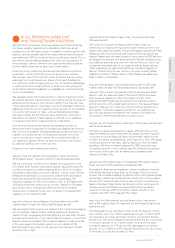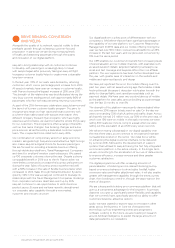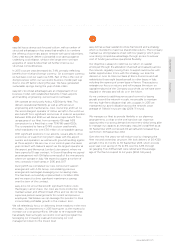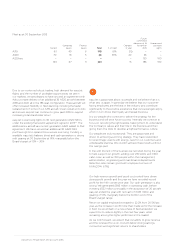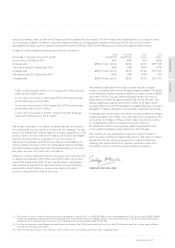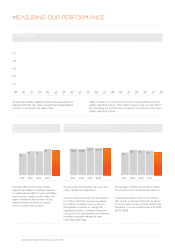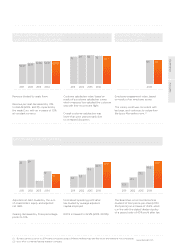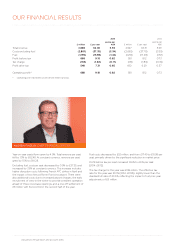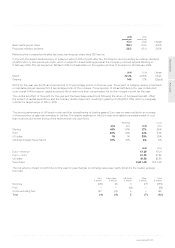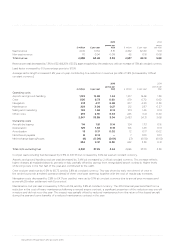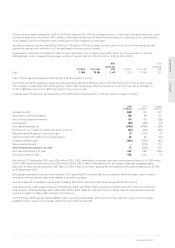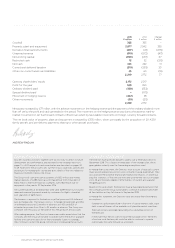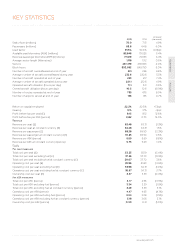EasyJet 2015 Annual Report Download - page 17
Download and view the complete annual report
Please find page 17 of the 2015 EasyJet annual report below. You can navigate through the pages in the report by either clicking on the pages listed below, or by using the keyword search tool below to find specific information within the annual report.
Strategic report Governance Accounts
13
www.easyJet.com
3MAINTAIN COST ADVANTAGE
easyJet has a strong cost-focused culture, with a number of
structural advantages in key areas that enable it to combine
the offering of a primary airport network with good value fares.
Every year easyJet delivers substantial cost savings against
underlying cost inflation, whilst in the longer term we have
a pipeline of opportunities that will further improve our
structural competitiveness.
In 2015 cost per seat decreased by 3.4%, primarily reflecting
benefits from fuel and foreign currency. On a constant currency,
ex-fuel basis cost per seat rose 3.6%. Part of this is the cost of
doing business within our successful business model; part was
due to one-off factors during the year. We have generated
sustainable savings during the year of £46 million.
easyJet’s structural advantages are an integral part of our
business model, with established benefits in fleet, airports
and handling, engineering, pensions and overheads:
• We operate an exclusively Airbus A320-family fleet. This
delivers operational flexibility as well as efficiencies in
engineering and maintenance, crew, ownership and fuel. As
the second-largest operator of Airbus aircraft in the world we
also benefit from significant economies of scale on acquisition.
Between 2016 and 2021 we will derive a major benefit from
up-gauging of our fleet, from a majority 156-seat A319
composition to a fleet that is over 70% 186-seat A320s.
This is expected to have a 13-14% cost per seat benefit,
which translates into over £110 million of comparable savings.
• With significant positions in our airports, we are able to drive
economies of scale from long term deals with the airport
owners and operators, as well as with ground handling agents
at those airports. We are now in our second year of a seven
year contract with Gatwick airport, as the largest operator at
the airport, and likewise at London Luton airport, where we
have signed a 10 year contract. In Ground Handling we signed
an arrangement with GH Italia covering all of the nine airports
where we operate in Italy. We expect to agree a number of
new contracts in both areas in 2016 and 2017.
• During 2015 we completed our new component support
arrangement with AJW Group, consolidating previous
arrangements and again leveraging our increasing scale.
This has been successfully implemented in October 2016
and we expect to drive significant maintenance savings
over the term of the contract.
• easyJet is not encumbered with significant historic costs
that legacy carriers have. Our crew are more productive. We
maintain a lean and efficient head office and we do not have
expensive pension arrangements for current and previous
employees. We believe we can leverage this position to drive
incrementally profitable growth in the medium term.
We will relentlessly focus on delivering these initiatives in the next
few years. Our experiences in 2015 have given us the impetus to
increase our cost saving efforts. We plan to re-invigorate what
has already been a hugely successful cost saving programme,
leveraging our increasing scale and reviewing our cost
management down to the lowest level.
4DISCIPLINED USE OF CAPITAL
easyJet has a clear capital structure framework and a strategy
which is intended to maximise shareholder returns. The Company
maintains a strong balance sheet with low gearing, which gives
us a strong competitive advantage through access to a lower
cost of funding as well as operational flexibility.
Our objective is always to optimise our return on capital
employed through the allocation of aircraft and capacity across
the network, regularly moving them to airports and routes with
better opportunities. In line with this strategy, we took the
decision in June to close our base at Rome Fiumicino and will
redistribute those eight based aircraft to other bases in Italy,
including the opening of a new base in Venice. These actions
reiterate our focus on returns and will increase the return on
capital employed of the Company as a whole, as we have done
regularly in the past and will do so in the future.
As we continue to add frequencies and commit to basing
aircraft around the network in scale, we are able to maintain
the very high fleet utilisation that sets us apart. In 2015 we
maintained our asset utilisation across the network, at an
average of 11 block hours per day (2014: 11 hours).
Fleet
We manage our fleet to provide flexibility in our planning
arrangements, so that on the one hand we can maximise
opportunities in a strong demand environment, whilst being able
to manage our capacity as necessary. easyJet’s total fleet as at
30 September 2015 comprised 241 aircraft and increased by a
net 15 from 30 September 2014.
Over the next five years we will reduce cost by changing the
fleet mix and ownership structure. We took delivery of 20 A320
aircraft in the 12 months to 30 September 2015, which provide
a per seat cost saving of 7% to 8% over the A319, through
up-gauging. Five A319 aircraft were retired and the average
age of the fleet increased to 6.2 years (2014: 5.8 years).


